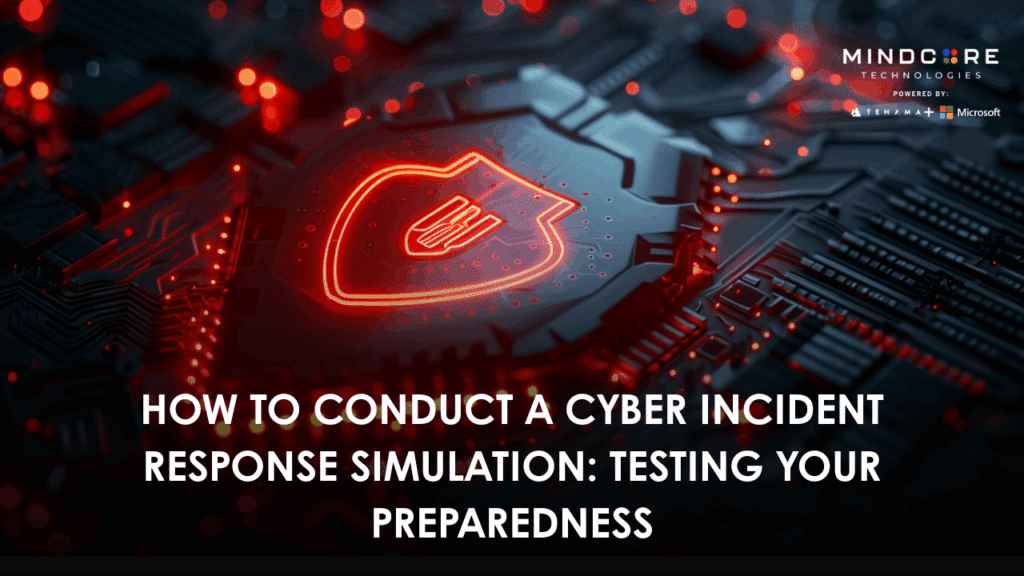No one wants their first real cyberattack to be their team’s first test. But that’s exactly what happens when companies skip cyber incident response simulations. These simulations give your team a chance to practice—not guess—when a real threat hits.
Running a response drill is like running a fire drill. You’re not trying to stop the fire in the moment. You’re preparing people to stay calm, follow steps, and recover fast—exactly the kind of readiness your entire cyber incident response strategy depends on, especially when paired with a strong foundation in cyber incident response.
In cybersecurity, it’s not enough to write a plan. You need to prove it works.
What Is a Cyber Incident Response Simulation?
A cyber incident response simulation is a structured test of your organization’s ability to respond to a cyberattack. It involves designing a realistic threat scenario and walking through the full response process with your team. Depending on your setup and goals, this can range from simple tabletop discussions to complex live simulations.
The point is to evaluate your cyber incident response plan, test your team’s coordination, and identify gaps in both tools and processes before an actual breach occurs.
Goals of a Cyber Response Simulation
Running a simulation isn’t just about going through the motions. You want to:
- Identify weaknesses in your response strategy
- Test communication channels under pressure
- Validate team responsibilities and coordination
- Practice decision-making and containment workflows
- Improve recovery and reporting procedures
A solid simulation shows you what’s working and what isn’t—before it really matters.
Before You Begin: Prep Work Matters
Start by setting a clear objective. What do you want to test? Maybe it’s how your team handles ransomware. Maybe it’s how quickly they escalate a phishing attempt. Pick a scenario that matches your current risk profile.
Then, define these basics:
- Scope: Which departments and systems are involved?
- Scenario: What type of cyber threat will you simulate?
- Timeline: When will it happen, and how long will it last?
- Observers: Who will monitor performance and take notes?
You should also review your incident classification process before starting. Knowing how to label and assess the severity of the event during a drill helps keep the simulation realistic.

Step-by-Step: How to Run a Cyber Response Simulation
Here’s how to walk through a simulation that actually helps your team get better:
Step 1: Choose a Realistic Scenario
Pick something your team could actually face. This makes the exercise relevant and keeps the team engaged.
Examples:
- A ransomware attack locks down your billing systems
- A phishing email steals login credentials
- A rogue employee copies sensitive files
The more relevant the threat, the more serious the team will take it.
Step 2: Notify and Brief the Team
Take time to tell participants they will be taking part in a simulation. Clarify that whatever is tested is a learning opportunity, not an opportunity to assign blame. Carefully limit the amount of detail given to participants if testing their response speed or coordination.
Step 3: Launch the Scenario
Present the scenario trigger as follows: “An alert shows unusual outbound traffic from your email server.” From there, allow the team to embrace their roles. Analysts could check logs.
Team leads could start the communication chain. Legal could start informing their role in reporting.
Here, the structure of your cyber incident response team will be tested.
Step 4: Guide the Exercise with Injects
Throughout the simulation, add new information in waves (called injects) to simulate how the incident might evolve.
Examples:
- Customer service reports users can’t log in.
- A partner company emails saying they received a strange file from you.
- The media is asking questions.
This approach keeps the scenario dynamic and requires the team to adapt.
Step 5: Track and Document Everything
Designate someone to observe and record the following:
- Who took the lead?
- What actions were taken, and how quickly?
- Were escalation paths followed?
- Did communication flow smoothly?
These notes are key to the post-simulation review. You’re not just tracking what happened, but how it happened.
Step 6: Conduct a Debrief
Right after the drill, bring everyone together. Review:
- What went well?
- What caused confusion?
- Were any tools missing or outdated?
- Did the playbooks help, or add friction?
Make this part collaborative. Let team members share their views and suggestions.
Step 7: Update Plans, Tools, and Training
Simulations are only useful if they lead to action. Take what you learned and:
- Refine your incident response playbook for clarity
- Add missing steps or roles to your response plan
- Update your contact list and tools
- Schedule new training where needed
This is also a good time to review your documentation process for incident response. Tracking logs, screenshots, and timelines should be clear and repeatable.
Common Pitfalls to Avoid
Even the best teams stumble if simulations aren’t set up properly. Watch out for:
- Making it too easy: Real incidents are messy. Simulations should reflect that.
- Skipping the debrief: If there’s no review, there’s no improvement.
- Only testing the IT team: Every department—from legal to HR—has a role.
- Treating it like a checkbox: This is practice for real life, not just compliance.
Avoid these mistakes, and your simulation will build real confidence.
Keeping Simulations Part of Your Strategy

A one-off simulation may highlight a few areas for improvement, but real progress comes from consistent testing. Keeping simulations part of your cybersecurity strategy means baking them into your annual calendar, tying them to actual threat models, and involving different departments each time.
You can start small—like a tabletop run for a phishing scenario—and grow to include larger exercises. In time, the habit of testing becomes part of your overall cyber readiness approach.
Many companies include cyber simulations as part of their flexible incident response planning. It’s not about having one big plan—it’s about being ready for anything.
When your team has practiced real-world scenarios, it becomes second nature to act fast when a real alert hits.
Final Thoughts
You don’t want your first real incident to feel like a surprise exam.
Cyber incident response simulations give your team a safe space to learn, make mistakes, and sharpen their strategy. They test your response playbooks, your team structure, and the tools you rely on.
If your plan looks great on paper but falls apart in action, it’s time to change that. Because when the stakes are high, experience matters.
Run the drill. Watch what breaks. Fix it. Then run it again. That’s how you build true cyber readiness.

